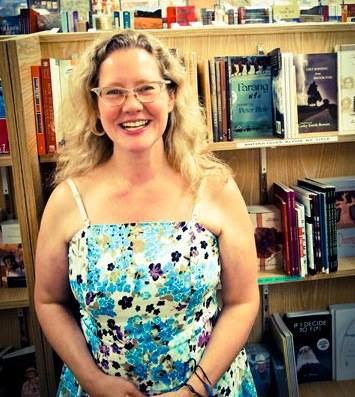BEFORE DAWN
upon looking at
Romare Bearden’s mosaic of the same name
at the
Charlotte Mecklenburg Public Library
The door opens, backlit
On a round purple rag rug mimosa mosaic
Before Dawn opens the mosaic door
Backlit onto round rug rag in spiral
Broom propped near another mother watching
Her daughter carry a bowl of green, round
Figs or sprouts? Her grandmother beckons
Open palmed over patchwork tablecloth
Of orange ball & bluegreen squares. At the same
Moment my mind flickers to my mother
Taking care of my daughter. I am the woman
Shadowing the doorway watching them play
Watching thy/ my mother
It feels
as though I’d barely finished and posted my review of American poet and filmmaker Lee Ann Brown’s third solo trade poetry collection, In the Laurels, Caught (Albany NY: Fence
Books, 2013) [see my review here] when another collection, Crowns of Charlotte NC ODE
(Durham NC: Carolina Wren Press, 2013), appears on my doorstep. Fifteenth in
their “Poetry Series,” Crowns of
Charlotte NC ODE follows very much in the footsteps of In the Laurels, Caught. Where the earlier collection explored
a more general territory, composed as “a collection of lighthearted,
deep rooted-poems written around the Appalachian region of North Carolina in
Madison County,” the
focus of Crowns of Charlotte NC ODE is
far more specific, exploring the city of Charlotte, North Carolina, where the
author was raised. Existing as an extension and companion volume to In the Laurels, Caught, Crowns
of Charlotte NC ODE is a study of Brown’s own point-of-origin, adding, with
these two collections, to a tradition that includes Andrew Suknaski’s Wood Mountain Poems (1976; 2006) and Arkansas
poet C.D. Wright’s ongoing work, as well as Toronto poet Sharon Harris’
work-in-progress writing Sarnia, Ontario, or my own collections writing
Glengarry County, Ontario: bury me deepin the green wood (ECW Press, 1999) and Glengarry
(Talonbooks, 2011). Brown explores the history, geography and people of
Charlotte, North Carolina, digging deep into the language and lilt of the
locals and her own family stories and archaeologies, as well as the history of
she whom the city is named for, utilizing details and exploring the space.
A LIST OF 19
SUITORS
So elegant my grandmother
So close to her father
That someone recognized her
A thousand miles away
Aquiline nose, large eyes
Skin translucent in photos
I knew her in wrinkles
Where I must have gotten
My under-eye designs
She had very fetching hats and
A sense of style to beat the band
When she brought the preacher
A cold glass of water
Clear eyes flash
Green goblet of glass
O perfect Love
He wasn’t on the list
Brown
seems to favour the song and the sonnet, as well as the ode, structures that
keeps coming up in what I’ve seen in her writing. Her poems are rich with sound
and rhythm, childhood recollection, historical anecdote, the music of John
Coltrane, juvenilia and a deep, abiding love. Sound, song, rhythm and speech play
integral roles in poems such as “ACOUSTIC WINTER,” “CAR CONVERSATION,” “HOMECOMING”
and “‘SCUSE MY BOARDINGHOUSE REACH,” running deep throughout the whole of the
collection. As the first stanza of “BALLAD OF WINSTON-SALEM” reads:
Sweet Deborah, she is dead, pretty baby, O
Sweet Deborah, she is dead, pretty daughter, O
Sweet Deborah she is dead
We lay flowers at her head
And across her final bed in the air-ee-o
One of
the strongest parts of the book comes from the final sequence in the collection,
the fifteen sonnet sequence, “Double Crown for Charlotte,” writing directly
around Charlotte of Mecklenburg-Strelitz (1744-1818), including the rumours of
her African ancestry. Queen Charlotte, after whom the city of Charlotte was
named, was wife of the “mad king,” King George III. In each poem, Brown
explores Queen Charlotte’s history, and uses the final line from each poem to
open the next piece, finally accumulating in the fifteenth sonnet, constructed
entirely out of these repeated lines. Through repetition, and variant usage,
the repeated lines shift, alter and change weight, turning themselves around
into new shapes. The sound of similar lines in a short space bring weight to
the poem, and to each line, altering all that emerges around them.
The town I grew up in is feminine—
To crown us all with a laurel wreath
I saw a map early on of North and South.
A gloss written in between lines:
The greatest monarch of the
north must bow
in the bedroom. King George whines:
O sing
of human DNA’s complexity—
A dog which shows its teeth but never dares
to decode a painting. One has to get close.
Who didn’t want to let go of their Queen?
Sophia Charlotte was also a painter,
but my favorite is a photograph.
Do me the favor to burn this
if you love me and believe me.




No comments:
Post a Comment